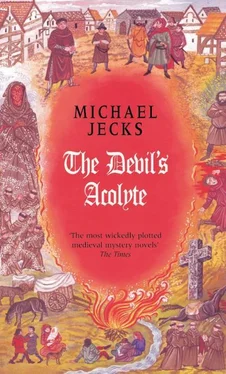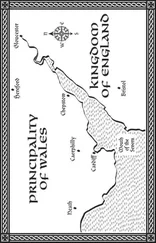Also known as Wally. An unsuccessful miner, Walwynus has spent the last few years eking a living from his smallholding while trying to locate another seam of tin.
Ellis
A barber. Monks are not allowed to bleed themselves, and all abbeys need a barber to open veins, as well as removing teeth and ensuring that cheeks and tonsures are neatly shaved.
Nob
Originally from the north of England, Nob runs a local pie-shop with his wife, Cissy.
Cissy
Wife to Nob, Cissy is also the unofficial aunt to all those young women who need help with their social lives or children.
Sara
Widowed while young, Ellis’s sister has recently become pregnant and is in need of a comforting shoulder to lean on.
Hamelin
The miner who took over Walwynus’ works, Hamelin is sorely troubled by his lack of success. His wife and family are in dire straits, but he can’t find the tin he needs.
Emma
Hamelin’s wife is desperately worried about her youngest son, Joel, who is showing signs of malnutrition.
Rudolf von Grindelwald
A Free Swiss from the Forest Cantons, Rudolf has come to Dartmoor with his wife Anna and family to buy tin, for he is a master pewterer.
Anna
Rudolf’s wife.
Welf and Henry
Two sons of Rudolf who have joined him on his trip to Devonshire.
Hal Raddych
One of the old school of Dartmoor miners, Hal is a near neighbour to Wally and Hamelin.
The story of the Abbot’s Way is one of those ancient tales which are all but impossible to validate. It’s true that many of the books which include the tale make the legend sound almost feasible… but not to a truly cynical mind. For one example, look at the little booklet Dartmoor Legends Retold – vol. II by T.H. Gant and W.L. Copley, published by Baron Jay.
I picked this story as the start point for my novel because it offers an attractive amount of detail – the name of the Abbot of Tavistock of the time (Walter), the fact that there was a dispute with the monks of Plymstock Abbey (I changed this to Buckfast because I can find no record of an abbey in Plymstock) and the name of the leading protagonist, Milbrosa. However, lest there be any doubt, I personally do not believe that the legend as retold here has any historical validity. It is a curiosity, nothing more.
In some ways this story shows the extreme difficulty of being accurate when you are writing historical works. While it is possible that somewhere amongst the old Abbey papers a record of the event exists, I seriously doubt it. If such a record was there, the keen eye of Professor H.P. R. Finberg would have spotted it years ago, and he would have gleefully reported it in his superb history Tavistock Abbey (Cambridge University Press, 1951).
The way that history, or much of it, has been passed down through the centuries is not by means of researched and authenticated material, but by word of mouth. Stories which once bore a shred of truth are now so embellished and distorted that the man behind the myth of Robin Hood, for example, would be hard put to recognise himself, just as the Dark Ages warlord King Arthur (if he ever existed) would be astonished to hear about Camelot and his Knights of the Round Table. Word-of-mouth stories were subsequently written down, of course, and then were copied out by others and used as ‘historical’ documents. In this way we learn of the flight of Brutus (not the assassin) from Troy and his eventual landing in Devonshire, where he wrestled with and beat the indigenous population of giants, thereby taking over the entire kingdom of England, Wales and Scotland. That story, originally invented by Virgil, appeared in many monastic histories after Geoffrey of Monmouth first penned it. Subsequently, when King Edward I needed a justification to lay claim to Scotland, his spin-doctors hit upon the idea of following up this Roman concept. If the original men to arrive on Albion found a single, discrete political unit which they conquered, the logic said, the island always had been one entity, and still should be; thus the King of England was obviously the King of Scotland and Wales.
The Scots disputed this. Then, as now, they distrusted the ‘spin’ or propaganda emanating from Westminster. This claim, and the Scottish rejection of it, was to bedevil Anglo-Scots relations for hundreds of years, until the Scots agreed to let the English share their Royal Family in 1603 (James VI of Scotland; James I of England).
So what of the Abbot’s Way itself?
We know that hundreds of years ago a series of stone crosses was erected in southern Dartmoor. At some point it was given the name of the Abbot’s Way. This could have been because the Victorians noticed that it ran from the Abbey at Buckland to the Abbey at Buckfast – but others have disputed this. R. Hansford Worth points out that many tracks across the moors were well-defined long before the monasteries were built. The path from Buckfast to Nun’s Cross is unmarked by crosses – although they could have been stolen, of course. In his book Worth’s Dartmoor (1967) he proposes that if the Abbot of Buckfast did sponsor a new path, it would have gone by Holne over the Holne Ridge to Horn’s Cross. From there it went over Horse Ford on the O Brook to Down Ridge (where there are two crosses), on to Ter Hill, and then to Childes Tomb via Mount Misery. After a cross west of Fox Tor Mire, it led to Nun’s, or Siward’s, Cross. After this section, the route follows more closely the way marked on modern Ordnance Survey maps.
Now, I cannot claim any great knowledge of this part of the moor, but I rather like Worth’s methodology: seeking out and following the line of all the crosses – and, of course, there were more of them in his time. And those which had gone in Worth’s day were still sometimes remembered by his contemporaries (who had themselves dug them up to use as gateposts), so for the purposes of this book I have assumed that Worth was correct. If you look at the map of the area, it is very noticeable that on the route suggested above, between Buckfast and Nun’s Cross, you pass nine stone crosses; by following the route marked as the ‘Abbot’s Way’ on the map, you pass two. If the Abbot’s Way was marked by crosses, which route is more likely?
If you wish to follow in the footprints of the story, I would recommend Eric Hemery’s excellent Walking Dartmoor’s Ancient Tracks (Robert Hale, 1986). Like me, Hemery prefers Worth’s route rather than the curious one given on the OS maps. And don’t forget to buy the Dartmoor Rescue Group’s book on walks in Dartmoor, because it gives excellent advice on all aspects of walking. Most of all, enjoy the feel of the moors. There are few places in our crowded little island where we can really see how things would have been, hundreds of years ago. Dartmoor has changed in many ways, but as you stand at Siward’s Cross and gaze south and east, it is easy to sense the millions of people who have tramped past here over the centuries, through rain and sleet, frozen to the marrow, undernourished and desperate, and weighed down by overwork.
I only hope you don’t feel the same as them!
Michael Jecks
Dartmoor
July 2001
When they sat down in the old man’s room on that Tuesday evening, it was the scar that initially held them all spellbound, rather than his stories.
The room was only small, the fire resting in a slight hollow in the middle of the floor, and the novices seated around it. The Almoner hunched forward, his elbows resting on his knees, his head moving from side to side as he studied each boy. Gerard the young acolyte felt a shudder of revulsion pass through his frame as Brother Peter’s gaze passed over him. In this dim light, the Almoner looked like a demon viewing his prey. Gerard almost expected to see him sprout wings.
Читать дальше












